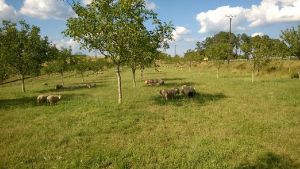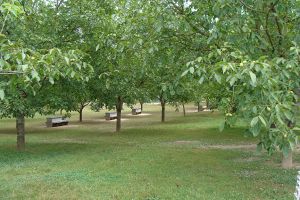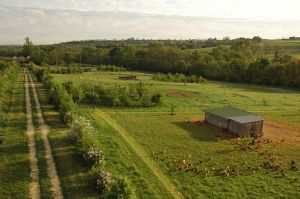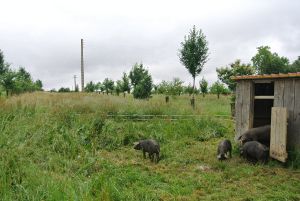 Wooded pastures, wooded meadows, shade, forage
Wooded pastures, wooded meadows, shade, forage

Agroforestry is the combination of trees and crops or animals on the same plot of land, either on the edge or in the open field. The aims of these cropping systems are to make better use of resources, increase biological diversity and create a microclimate conducive to higher yields.
This portal page provides an overview of the applications of these practices to livestock farming (ruminants, pigs, poultry, etc.).
Themes
Interests and objectives
Main agronomic principles
Generally speaking, theassociation of trees and crops is designed to create optimum development conditions at plot level. The interests sought includedeep root exploration, which makes available water and mineral reserves that are normally inaccessible, the creation of a more stable microclimate, soil fertilisation (thanks tonitrogen-fixing species or the humification of dead leaves), diversification of production, etc. Designing an agroforestry project therefore requires thinking about a range of cross-cutting techniques, which need to be adapted to the specific features of the farm.
Livestock production


The presence of trees in plots can also provide a number of services specific to livestock farming, such as :
- The production of woody fodder, which makes it possible to diversify animal rations and compensate for the lack of grass at the end of summer for ruminants.[1]. It is important to select species with good palatability for optimal fodder. For cattle, privet, fusain, blackthorn, chestnut, maple, ash, black locust, alder and willow are often considered to be suitable species.[2].
- Contributing to animal welfare, in particular by creating runs (with trees or shrubs) in free-range poultry farms, or shaded areas in grazed meadows. In some cases, these facilities can even supplement animal feed, with berries and naturalinsect populations for poultry or acorns for pigs, for example.
- Adding value to woody biomass through the production of wood chips, which can provide better quality bedding than straw at a lower and less fluctuating cost.[3].
Major agroforestry developments in livestock farming
In addition to the wide variety of objectives, the association between trees and livestock can also take a wide variety of forms, which need to be adapted according to local characteristics and the interests sought.
Hedges
Hedges and banks planted with trees or shrubs are one of the most common agroforestry structures. They can be used to delimit pastures or cultivated areas in bocages, or as a source of additional fodder, or even as a windbreak for cultivated plots. Like all agroforestry developments, they provide an additional ecological niche and reinforce the continuity of environments, thereby encouraging biodiversity.
Intra-parcel developments


Within plots, the planting and maintenance of trees can have a primarily landscape interest, particularly in the case of isolated trees, stream banks and copses. As with hedges, these can provide shelter or a source of food for animals.
However, there are also more substantial arrangements with a real production objective : orchards, where the ground surfaces can be cultivated or grazed (these are known as "high-stem orchards"), as well as rows of trees intended for the production of timber or fragmented ramial wood. ramial fragmented wood. Such structures are sometimes used to facilitate the establishment of paddocks, particularly for dynamic rotational grazing.
Rangelands are another example of intra-parcel development, widely used on poultry and sometimes pig farms. They reduce animal stress by providing covered areas to protect them from bad weather, sunlight and predation by birds of prey. In fact, they guarantee greater exploration and occupation of the plot: the result is better use of nutrient resources, as well as a reduced risk of parasites (because droppings are more widely scattered). [4]
Sylvopastoralism and eco-grazing
Sylvopastoralism is a sustainable form of forest management, maintained by grazing (often small ruminants : sheep and goats). It makes the most of the diversity of fodder resources under the trees, thus thinning out the forest : promoting wood production and reducing the potential spread of fires.
Eco-grazing in the broadest sense of the term can also be seen as an association between agroforestry and livestock farming, particularly when animals are introduced into certain productive areas, such as orchards, to maintain them and regulate bio-aggressors.
Constraints and limitations
Although the applications of agroforestry to livestock farming are many and varied, there are still a number of general points to be aware of :
- In orchards, it is important to take care and remove the animals a month before and after the harvest, to avoid them eating part of the crop, or falling ill from eating spoilt fruit. By the same token, the combination of livestock farming and agroforestry may imply a need to reduce phytosanitary treatments in order to protect animals from possible poisoning.[5].
- The introduction of animals into agroforestry systems may mean that trees need to be protected, particularly young trees and low stems.[5].
- The use of trees in systems historically specialised in livestock farming can also cause certain inconveniences, such as : thehindrance of certain mechanical operations, the need to learn new skills, and the time and money required to invest several years before achieving a fully productive agroforestry system.[6].
- In the case of larger ruminants, certain tree cover systems can cause greater"discomfort due to insects", despite an overall positive effect on animal welfare.[7].
- In areas affected by drought and low soil reserves, water competition can adversely affect the productivity of agroforestry plots.[6].
References
- ↑ Delphine SCOHY, Web-Agri, Trees in cattle rations. 2020. https://www.web-agri.fr/fourrage/article/168906/des-arbres-dans-la-ration-des-bovins
- ↑ Estelle ROPERS, Réussir Agri 53 ; "Grazing woody plants, why not ?". 2020. https://www. agri53.fr/paturage-de-ligneux-pourquoi-pas
- ↑ Agr'eau, technical document : Valoriser la biomasse en litière plaquette, 2019. http://agreau. fr/wp-content/uploads/2019/04/agroforesterie-fiche-thematique-utiliser-les-plaquettes-en-litiere-et-valoriser-la-biomasse-elevage-paillage-avril-2015.pdf
- ↑ C. BÉRAL et al, Technical guide : aménagement arborés des parcours de volailles, 2015. https://www.itavi.asso.fr/content/guide-technique-amenagement-arbores-des-parcours-de-volailles
- ↑ 5.0 5.1 C. Béral et al, AGROOF SCOP, ETAT DES LIEUX DES PRATIQUES : La place l'agroforesterie dans les élevages ovins, 2018. http://www.rederural.gov.pt/centro-de-recursos/send/2-agricultura-agroindustria/959-agroforesterie-en-systeme-d-elevage-ovin-etude-de-son-potentiel-dans-le-cadre-de-l-adaptation-au-changement-climatique
- ↑ 6.0 6.1 S. Debarge, ADEME, Réintégrer l'arbre dans les systèmes agricoles, 2015. https://www.ademe.fr/sites/default/files/assets/documents/7-reintegrer-l-arbre-dans-les-systemes-agricoles-reference-ademe-8183.pdf
- ↑ C. Ginane and M. Bernard, INRAE, Behaviour and well-being : impact de la présence d'arbres, 2018. http://www.rederural.gov.pt/centro-de-recursos/send/2-agricultura-agroindustria/959-agroforesterie-en-systeme-d-elevage-ovin-etude-de-son-potentiel-dans-le-cadre-de-l-adaptation-au-changement-climatique